Hair microtransplant
Hair transplantation by follicular micrografting is a minimally invasive procedure that causes almost no pain. The healthiest hairs of your own head are selected and transplanted into the bald area, unit by unit, with the greatest precautions to avoid damaging its most precious characteristic: vitality. The transplanted hairs draw a completely natural insertion line on the forehead, thanks to the ultraline design, which avoids the continuous lines, copying the natural inclination of the rest of the hair in the implantation area. They cover scars that may have been left behind as a result of accidents or previous surgeries. As the donor area is generally smaller than the target area, the micrografts are distributed evenly, with a lower density than the original, but very uniform. This produces a totally natural result, different from the old transplants of many hairs each, which became famous years ago for its doll hair appearance. It is done in a session of 3 or 4 hours, with local anesthesia, and does not require bandages. They can be intercalated between other hairs that have been transplanted in a previous session, without hurting them, to increase the density of the area. These micrografts are never rejected by the body because they belong to the skin of the same patient. Your personal image will improve a lot. Your head will be covered with completely natural hair that will accompany you throughout your life. The genetic information of your transplanted hair will prevent you from dying, regardless of where you are. Every time you go to work or a social gathering, you will feel the joy of combing your head again as you did when you were younger.
Considerando un microtransplante capilar
El trasplante capilar por microinjerto folicular es un procedimiento poco invasivo que casi no ocasiona dolor. Los pelos más saludables de su propia cabeza son seleccionados y trasplantados hacia la zona calva, unidad por unidad, con los mayores recaudos para no dañar su característica más preciada: la vitalidad. Los pelos trasplantados dibujan una línea de inserción totalmente natural sobre la frente, gracias al diseño personalizado, que evita las líneas continuas ,copiando la inclinación natural del resto del pelo en la zona de implantación. 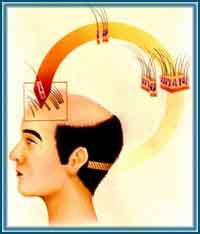 Cubren cicatrices que pudieran haber quedado como secuelas de accidentes o cirugias previas. Como el área dadora es generalmente menor que el área de destino, los microinjertos se distribuyen de manera pareja, con una densidad menor que la original, pero muy uniforme. Esto produce un resultado totalmente natural, diferente de los antiguos trasplantes de muchos pelos cada uno, que se hicieron famosos años atrás por su apariencia de pelo de muñeca Se realiza en una sesión de 3 o 4 horas, con anestesia local, y no requiere vendajes. Pueden ser intercalados entre otros pelos que hayan sido trasplantados en una sesión previa, sin lastimarlos, para aumentar la densidad de la zona. Estos microinjertos (micrografts) nunca son rechazados por el organismo porque pertenecen a la piel del mismo paciente. Su imagen personal mejorará mucho. Su cabeza volverá a estar cubierta de pelo completamente natural que lo acompañará durante toda la vida. La información genética de su pelo trasplantado evitará que muera, independientemente del lugar donde se encuentre. Cada vez que vaya al trabajo o a una reunión social, sentirá la alegría de volver a peinar su cabeza como lo hacía cuando era más joven.
Cubren cicatrices que pudieran haber quedado como secuelas de accidentes o cirugias previas. Como el área dadora es generalmente menor que el área de destino, los microinjertos se distribuyen de manera pareja, con una densidad menor que la original, pero muy uniforme. Esto produce un resultado totalmente natural, diferente de los antiguos trasplantes de muchos pelos cada uno, que se hicieron famosos años atrás por su apariencia de pelo de muñeca Se realiza en una sesión de 3 o 4 horas, con anestesia local, y no requiere vendajes. Pueden ser intercalados entre otros pelos que hayan sido trasplantados en una sesión previa, sin lastimarlos, para aumentar la densidad de la zona. Estos microinjertos (micrografts) nunca son rechazados por el organismo porque pertenecen a la piel del mismo paciente. Su imagen personal mejorará mucho. Su cabeza volverá a estar cubierta de pelo completamente natural que lo acompañará durante toda la vida. La información genética de su pelo trasplantado evitará que muera, independientemente del lugar donde se encuentre. Cada vez que vaya al trabajo o a una reunión social, sentirá la alegría de volver a peinar su cabeza como lo hacía cuando era más joven.
Hair microtransplant concept
The concept of hair transplantation arises from the observation of hair behavior in the different areas of the head. The hairs located in the upper area have genetic information that makes them sensitive to the effects of hormones, which cause an early termination of their life cycle and its consequent fall. In contrast, the hairs of the lateral and occipital areas (posterior, on the neck) are genetically programmed to preserve their vitality throughout life. 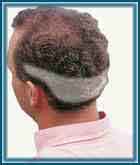
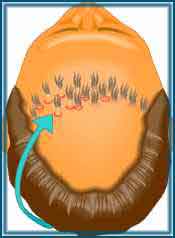 Therefore, theoretically, if a hair from the back is transplanted to the front, it will retain all its resistance properties and its genetic information to continue living the same number of years that it would have lived in its place of origin. This theory is totally correct, as long as the procedure is carried out with the necessary care. If a follicle is damaged during the transplant process, it can react with lack of growth in its destination, or grow too weak. We are well aware that perennial hairs are a scarce and limited resource and should not be wasted. There are only a certain number of hairs available for transplantation and no more: once they are exhausted, they have no replacement. Therefore, we must ensure that the highest possible number of transplanted hairs survives the transplant successfully, and that is why we have the most accurate instruments to collect the follicles in the neck area, process them in a culture medium and an ideal temperature, and implant them in other parts of the head.
Therefore, theoretically, if a hair from the back is transplanted to the front, it will retain all its resistance properties and its genetic information to continue living the same number of years that it would have lived in its place of origin. This theory is totally correct, as long as the procedure is carried out with the necessary care. If a follicle is damaged during the transplant process, it can react with lack of growth in its destination, or grow too weak. We are well aware that perennial hairs are a scarce and limited resource and should not be wasted. There are only a certain number of hairs available for transplantation and no more: once they are exhausted, they have no replacement. Therefore, we must ensure that the highest possible number of transplanted hairs survives the transplant successfully, and that is why we have the most accurate instruments to collect the follicles in the neck area, process them in a culture medium and an ideal temperature, and implant them in other parts of the head.
Planning your surgery
In the initial consultation we will make a forecast of how your scalp will evolve in the long term. To make an adequate design of the implantation, it is necessary to calculate if the baldness will continue to increase or stop. Classification of the type of alopecia 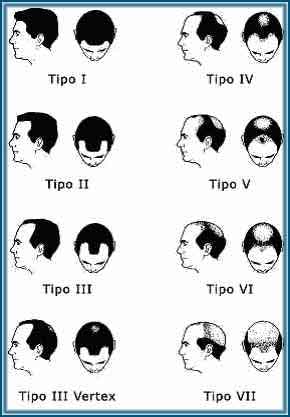 It is not good to completely exhaust the donor area in a design that may be visually perfect today, but if the baldness increases it will be inadequate in the future. If an area of your head has hair with evidence of irreversible weakening, we will apply the transplants as if you were already bald completely. The number of transplants to be performed may vary between one person and another. While the actual amount of hair is important, it is also very important the visual effect it produces, which depends, above all, on the degree of contrast between the hair and the skin, the average thickness, the amount of hairs per hair. follicular unit and its degree of undulation. It is also essential to evaluate the availability of the donor area.
It is not good to completely exhaust the donor area in a design that may be visually perfect today, but if the baldness increases it will be inadequate in the future. If an area of your head has hair with evidence of irreversible weakening, we will apply the transplants as if you were already bald completely. The number of transplants to be performed may vary between one person and another. While the actual amount of hair is important, it is also very important the visual effect it produces, which depends, above all, on the degree of contrast between the hair and the skin, the average thickness, the amount of hairs per hair. follicular unit and its degree of undulation. It is also essential to evaluate the availability of the donor area.
Preparing for your surgery
We will give you specific instructions on how to prepare for surgery, including certain suggestions about what you should eat and drink, about smoking, about what vitamins or medications you should take or avoid, and how to wash your face. Follow these instructions carefully, which will help your surgery to go unhindered and you will also have a more comfortable postoperative period. When making preparations, be sure to arrange for someone to accompany you home after surgery and help you for a few days, if necessary.
Where will your surgery be done?
The surgery is performed in our operating room, which has all the necessary medical equipment and the greatest comfort for you. You should arrive about 30 minutes before the scheduled time, to make the entry procedures, make a complete medical history, and take preoperative photographs. In your room we will give you a sedative by mouth and you can change clothes. After the surgery, he will stay in the clinic for two to four hours, until we make sure everything is in order and he can return to his home, where he will continue to rest.
Types of anesthesia
The capillary micro-transplant can be performed under local anesthesia. With this local anesthetic, your scalp will be completely numb, which will make you feel no pain; You will be awake during surgery, however, you will be relaxed and insensitive to pain. In case you want it you can perform the surgery under mild sedation.
Surgery
The capillary microtransplant lasts approximately 4 to 6 hours. We will cut the hair of a horizontal strip in the area of permanent growth, that is, on the nape of the neck or on the sides of its head. Then we will surgically remove this strip of skin, which is generally 1.5cm wide and between 14 and 18cm long, and we will carefully suture the edges of the resulting wound. The auxiliary equipment will extract the follicular units from it, so that they are ready for implantation. Those of a single hair are placed in the most visible area: the region closest to the forehead.

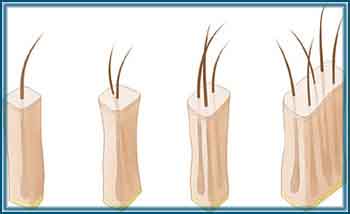
 This gives that region a very natural appearance and mobility, thanks to the personalized design that avoids drawing a continuous line. Units with 2 or 3 hairs are placed further back. Units of more than three hairs are very useful for the upper or coronal zone, where density is very important. If single-hair micrografts are placed on the entire head, any backlighting (such as that which affects us when we pass under a ceiling lamp, for example), would produce a visual effect of transparency in the transplanted hair. If you want to obtain a higher density, it is possible to carry out a second session in the future to intercalate new hairs among those already transplanted. For this it will be necessary to wait a few months until the hairs transplanted in the first session become established and resume their normal growth. In each session it is possible to transplant around between 4000 and 5000 hairs. The area that lies farther on the forehead is always made first.
This gives that region a very natural appearance and mobility, thanks to the personalized design that avoids drawing a continuous line. Units with 2 or 3 hairs are placed further back. Units of more than three hairs are very useful for the upper or coronal zone, where density is very important. If single-hair micrografts are placed on the entire head, any backlighting (such as that which affects us when we pass under a ceiling lamp, for example), would produce a visual effect of transparency in the transplanted hair. If you want to obtain a higher density, it is possible to carry out a second session in the future to intercalate new hairs among those already transplanted. For this it will be necessary to wait a few months until the hairs transplanted in the first session become established and resume their normal growth. In each session it is possible to transplant around between 4000 and 5000 hairs. The area that lies farther on the forehead is always made first.
After surgery
We do not usually put bandages around your head after surgery. You may have some discomfort after surgery, which will be totally controllable with the analgesic medication that we will prescribe. The biggest annoyance will be the sensation of tightness that probably has around the scar of the donor area. The points of the donor area are removed one to 3 weeks after the transplant. The tiny punctures where each follicular unit was planted become invisible very soon. Each micrograft will produce a small scab that will come off by itself after a week. The scar of the donor area is completely hidden under the hair. You must rest for 24 hours. At 48 hours you can wash your head following the instructions that we will give you, designed to avoid the formation of crusts in the donor area, but taking special care not to put pressure on the newly transplanted area. After 7 days you can wash your head normally. For a month it is not advisable to expose your head to the sun, not because the sun itself harms your transplants, but to avoid the burning sensation that can cause you to scratch. During the first 2 or 3 days it is convenient to sleep in a semi-sitting position to reduce inflammation and facilitate the recovery process. It is likely that there is no visible inflammation during the first 24 hours. At 48 hours there is a peak of swelling in the forehead, with an edema that usually descends to the area of the eyebrows and eyelids. Do not worry if you see that the transplanted hairs fall off and fall. It is normal. The roots remain healthy, but at rest. Usually 80% of the transplanted hairs falls, and the remaining 20% does not fall but remains inactive. It is necessary to wait approximately 3 months before the follicles are activated again and we can see the hair growing in its new place at a rate of between 1 and 1.5cm per month.
Returning to normal
For about a year, these hairs will be thicker than they had in their place of origin, and then they will return to their normal thickness. Once the transplanted hairs have recovered their vitality, it is possible to perform a second transplant session to increase the capillary density achieved in the first session, if this is not enough for your taste.
Your new look
Your personal image will improve a lot. Your head will be covered with completely natural hair that will accompany you throughout your life. The genetic information of your transplanted hair will prevent you from dying, regardless of where you are. Every time you go to work or a social gathering, you will feel the joy of combing your head again as you did when you were younger.
Potential risks or complications
You may feel some temporary insensitivity in the donor area or in the recipient, for 2 to 6 months. During the recovery period and before the transplanted hairs grow back, it is likely that some of them will produce a yellow granite and give the impression of being infected. Actually what these granites contain is not pus but fat produced by the sebaceous gland corresponding to that follicle. If this problem is not solved alone, it is necessary to tear off the costrite that obstructs the respective pore and squeeze it to force the expulsion of the fat.
